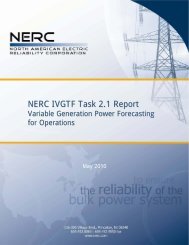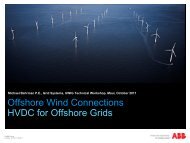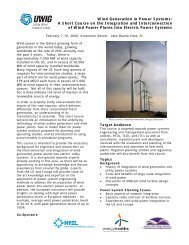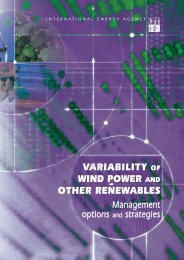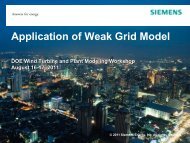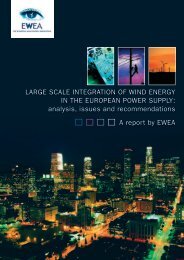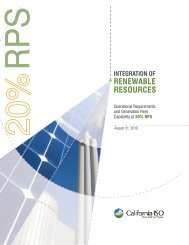Integrating Southwest Power Pool Wind to Southeast Electricity ...
Integrating Southwest Power Pool Wind to Southeast Electricity ...
Integrating Southwest Power Pool Wind to Southeast Electricity ...
Create successful ePaper yourself
Turn your PDF publications into a flip-book with our unique Google optimized e-Paper software.
decreasing smaller amounts. It is interesting <strong>to</strong> note that, even though the wind is committed day<br />
ahead in only the Entergy, SBA and TVA regions of SERC, the other SERC regions also end up<br />
decreasing generation in the economic dispatch phase, as it is less expensive <strong>to</strong> the entire system<br />
that they do so.<br />
Figure 5-1<br />
Effect of wind on system; blue indicates and increase in generation, orange a decrease in<br />
generation<br />
Considerations for SPP Providing All Within-Hour Balancing for Scenario #1<br />
The model does not show that Scenario #1, where SPP provides the within hour balancing for all<br />
48 GW of wind, results in a loss of load reliability issue, as may have been expected when a<br />
system with a peak of 55 GW has <strong>to</strong> manage almost 48 GW of installed wind. Although initially<br />
unexpected by the project team, after consideration of the results, the following reasons for this<br />
result are provided:<br />
• High reserve margin modeled. The planned generation for the Non-RES case is<br />
maintained for the high wind generation cases such that no plant is assumed <strong>to</strong> be retired<br />
despite the large increase in wind generation installed as we move from the 7 GW <strong>to</strong> 48<br />
GW case. Therefore, SPP is left with large amounts of resources, both <strong>to</strong> meet energy and<br />
reserve requirements. Even not considering wind, it still has a reserve margin of 20%<br />
above peak demand (and as has been shown in the past, wind will have some capacity<br />
credit).<br />
• Availability of reserve capable generation. Although the regulation requirements<br />
increase <strong>to</strong> 1.6 GW and spinning reserve increased <strong>to</strong> 3 GW, there is 4.5 GW of<br />
regulation capacity and 9.5 GW of spinning capacity. Although some of these capacities<br />
overlap, sufficient reserves are available assuming that the commitment and dispatch<br />
select the appropriate resources for providing energy and leaving available capacity on<br />
5-3




